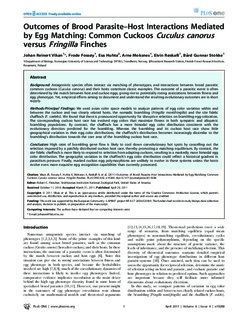| dc.contributor.author | Vikan, Johan Reinert | |
| dc.contributor.author | Fossøy, Frode | |
| dc.contributor.author | Huhta, Esa | |
| dc.contributor.author | Moksnes, Arne | |
| dc.contributor.author | Røskaft, Eivin | |
| dc.contributor.author | Stokke, Bård Gunnar | |
| dc.date.accessioned | 2015-10-30T08:20:53Z | |
| dc.date.accessioned | 2015-11-26T10:18:35Z | |
| dc.date.available | 2015-10-30T08:20:53Z | |
| dc.date.available | 2015-11-26T10:18:35Z | |
| dc.date.issued | 2011 | |
| dc.identifier.citation | PLoS ONE 2011, 6(4) | nb_NO |
| dc.identifier.issn | 1932-6203 | |
| dc.identifier.uri | http://hdl.handle.net/11250/2365829 | |
| dc.description.abstract | Background:
Antagonistic species often interact via matching of phenotypes, and interactions between brood parasitic common cuckoos (Cuculus canorus) and their hosts constitute classic examples. The outcome of a parasitic event is often determined by the match between host and cuckoo eggs, giving rise to potentially strong associations between fitness and egg phenotype. Yet, empirical efforts aiming to document and understand the resulting evolutionary outcomes are in short supply.
Methods/Principal Findings:
We used avian color space models to analyze patterns of egg color variation within and between the cuckoo and two closely related hosts, the nomadic brambling (Fringilla montifringilla) and the site fidelic chaffinch (F. coelebs). We found that there is pronounced opportunity for disruptive selection on brambling egg coloration. The corresponding cuckoo host race has evolved egg colors that maximize fitness in both sympatric and allopatric brambling populations. By contrast, the chaffinch has a more bimodal egg color distribution consistent with the evolutionary direction predicted for the brambling. Whereas the brambling and its cuckoo host race show little geographical variation in their egg color distributions, the chaffinch's distribution becomes increasingly dissimilar to the brambling's distribution towards the core area of the brambling cuckoo host race.
Conclusion:
High rates of brambling gene flow is likely to cool down coevolutionary hot spots by cancelling out the selection imposed by a patchily distributed cuckoo host race, thereby promoting a matching equilibrium. By contrast, the site fidelic chaffinch is more likely to respond to selection from adapting cuckoos, resulting in a markedly more bimodal egg color distribution. The geographic variation in the chaffinch's egg color distribution could reflect a historical gradient in parasitism pressure. Finally, marked cuckoo egg polymorphisms are unlikely to evolve in these systems unless the hosts evolve even more exquisite egg recognition capabilities than currently possessed. | nb_NO |
| dc.language.iso | eng | nb_NO |
| dc.publisher | Public Library of Science | nb_NO |
| dc.title | Outcomes of brood parasite-host interactions mediated by egg matching: Common cuckoos Cuculus canorus versus Fringilla finches | nb_NO |
| dc.type | Journal article | nb_NO |
| dc.type | Peer reviewed | en_GB |
| dc.date.updated | 2015-10-30T08:20:53Z | |
| dc.source.volume | 6 | nb_NO |
| dc.source.journal | PLoS ONE | nb_NO |
| dc.source.issue | 4 | nb_NO |
| dc.identifier.doi | 10.1371/journal.pone.0019288 | |
| dc.identifier.cristin | 800721 | |
| dc.description.localcode | © 2011 Vikan et al. This is an open-access article distributed under the terms of the Creative Commons Attribution License, which permits unrestricted use, distribution, and reproduction in any medium, provided the original author and source are credited. | nb_NO |
